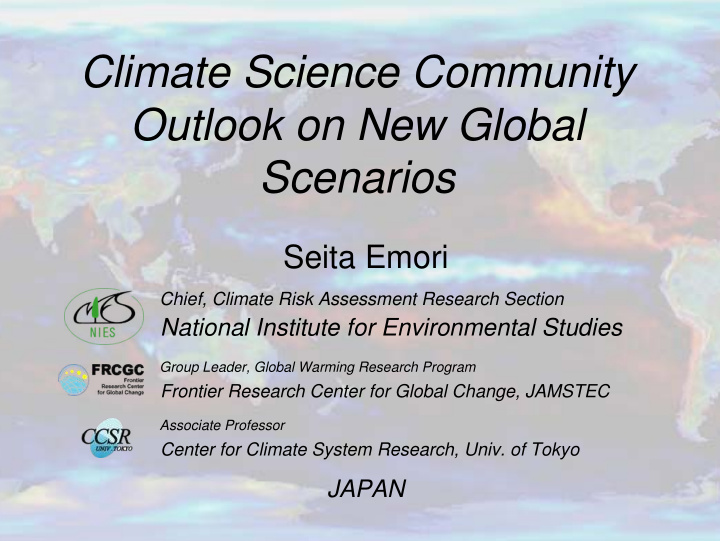



Climate Science Community Outlook on New Global Scenarios Seita Emori Chief, Climate Risk Assessment Research Section National Institute for Environmental Studies Group Leader, Global Warming Research Program Frontier Research Center for Global Change, JAMSTEC Associate Professor Center for Climate System Research, Univ. of Tokyo JAPAN
“Aspen Proposal” 1. Near term (2005~2030) 2. Long term (2005~2100 and beyond) • Defines the next coordinated climate model experiments for AR5 • Being discussed in AOGCM and ESM communities (WCRP/CMACC and IGBP/AIMES; Hibbard and Meehl, submitted to EOS ) • Needs communication with socio-economic scenario (IAM) and impact communities
Near term (2005-2030) • How weather and climate extremes will change on regional scales? • Require finer resolution models (at least 0.5 ° ~1 ° atmospheric) • A minimum of 10 ensemble simulations for each case recommended • Desirable to start from an observed initial state
Insensitive to emission scenarios Global mean Stott and Kettleborough (2002) • Based on a single scenario • High, medium and low pollutants cases may be useful (optional)
A misleading report… People in a hurry who leave the house on a sunny morning minus their umbrella only to find themselves drenched by an afternoon downpour will have no excuses if scientists in Japan succeed in an ambitious quest to forecast bad weather. The country's science ministry has unveiled plans to harness the power of the Earth Simulator, until recently the world's fastest supercomputer, to predict the weather up to 30 years into the future. Guardian, UK, 18 July, 2006
Change in frequency of extreme warm night Will it be robustly detected in ~2030 prediction? 10 member ensemble of MIROC-med (w/o realistic initialization) 2011-2030 1981-2000 Change in Frequency of warm night (ratio to the base period:1951-1970) Number of runs that show increase
Start from an observed state? A hindcast experiment by MIROC-med • Some skill in predicting next year’s El Ni ño • Decadal prediction is still a big challenge • Climate drift due to model bias
High resolution → Extreme/Regional A tropical cyclone-like vortex in a ~0.5 ° resolution model still too weak Central Pressure 928 hPa as a major TC (Cat 2) Maximum Wind Speed 44 m/s
Long term (2005-2100 and beyond) • To quantify feedbacks in the Earth system affected by various socio-economic and policy considerations (e.g., stabilization) • Carbon cycle feedbacks would be important • A low and high benchmark stabilization concentration experiment would be run • Calculate an implied CO2 emission time series that is provided to IAM groups
“Reverse Approach” Forward approach (Traditional) Reverse approach (New Strategy)
Benchmark scenarios • Technical paper to identify benchmark “emission” scenarios (IPCC-25 Decision, Mauritius) • Aspen proposal needs benchmark “concentration” scenarios ( may lead to redefining the role of technical paper? ) • Small number (2~3) and “well-separated” scenarios are preferable from climate modelers’ perspective
Spatial patterns insensitive to scenarios Trend maps of SAT (2001-2100) normalized by global mean SAT trends [K/K] SRES A2 SRES A1B A2 minus B1 SRES B1 MIROC3.2_medres model
Spatial patterns insensitive to scenarios Trend maps of precipitation (2001-2100) normalized by global mean SAT trends [mm/day/K] SRES A2 SRES A1B A2 minus B1 SRES B1 MIROC3.2_medres model
Recommendation Use simple climate models that you may already have in your IAMs to estimate the climate responses to various scenarios by interpolation from the responses to the benchmark scenarios. An energy balance model to get global mean Δ T + simple scaling of geographical patterns may be enough!
Will the determination of benchmark scenarios be political? • I HOPE NOT! • A benchmark concentration should not be regarded as a political target (eg., 450ppm vs. 550ppm etc.) nor “representative” in any sense. • It should cover the possible socio-economic range, but only roughly. • Two scenarios should be well-separated to make meaningful set of climate model runs. • Political target can be discussed after you get a range of scenarios and the climate responses to them through the interpolation process.
What are missing? 1. Treatment of non-CO 2 GHGs 2. Separation of emissions from fossil fuel and from land-use change 3. Spatial patterns of emissions and land-use change Maybe we can rerun climate models later for some selected socio-economic scenarios to have some full-consistent sets of socio-economic, emission, concentration and climate scenarios?
About the Timeline Climate modelers may be requested to make the simulations available as soon as possible. It may mean there would be no time to improve the models since AR4 (except for carbon cycle and resolution), … which is a shame.
Recommend
More recommend